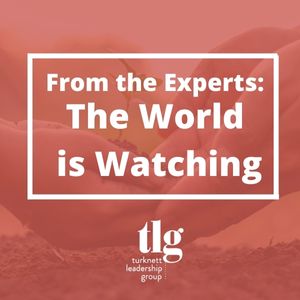
The world is watching. The focus on how organizations are handling corporate social responsibility and environmental, social, and governance initiatives has been magnified. The expectations of shareholders, employees, and consumers alike have shifted drastically and now go far beyond provision. Employees seek a greater purpose and support. They want to know that they are part of something bigger than themselves and making an impact on the world. This has created a profound challenge for leaders today, who are tasked with addressing these issues while walking their talk. We asked our team of experts what kind of efforts they feel people are looking for in organizations, and how leaders can walk the talk.
Answers From the Experts:
 Lyn Turknett, Co-founder and Co-chair, TLG
Lyn Turknett, Co-founder and Co-chair, TLG
We know the world is watching. What efforts are people looking for in organizations today?
One of the hallmarks of aging I’ve learned is realizing just how much you don’t know (the internet age has surely exaggerated this phenomenon). I’ve followed the Conscious Capitalism movement since I heard Raj Sisodia at the Academy of Management conference shortly after he and John Mackey, founder of Whole Foods, wrote the seminal book on the movement.
I’m admittedly no expert in sustainability, but I’ve followed Corporate Social Responsibility (CSR) efforts and seen the rise of Environmental, Social, Governance (ESG) reporting. I applauded the Business Roundtable’s new “Statement on the Purpose of the Corporation” moving away from shareholder primacy and embracing all stakeholders – customers, employees, suppliers, communities, and shareholders.
I’ve watched and supported goBeyondProfit, a Georgia-based organization founded by Rick and Shane Jackson, founders of Jackson Healthcare, who believe that business has the obligation to be a force for good.
But I had another “how did I not know that” moment this week when I discovered justcapital.com. This is an organization that has existed for about ten years and was founded to support this mission:
We believe that business can and must be a greater force for good and that markets must be part of the solution. At over $18 trillion, the U.S. private sector is about four and a half times the size of government and 40 times the size of private philanthropy. Building a more just economy that better serves the needs of all stakeholders is an essential step in pursuing true prosperity for all, and addressing our systemic problems at scale.
What Stakeholders are Looking ForI discovered Just Capital when I listened to the newest episode of Gary Hamel’s “New Human Movement” podcast, and Martin Whittaker, CEO of Just Capital, was his guest. Martin explained how his organization ranks companies, has “Just Calls” with CEOs to discuss what they are doing, and does a lot of surveying of the public. They argue that public views are good proxies for what people – including employees – expect from companies, and they say that the data shows a broad agreement across age, gender, race, and political point of view. Some of the things people expect organizations to do are:
- Pay People Fairly
- Provide good jobs and career progression
- Dire a diverse workforce
- Help support strong communities
- Lead with people who are ethical and trustworthy
That’s not a bad list, and Raj Sisodia goes even further in his recent book, The Healing Organization. Sisodia says that organizations can go beyond profit to alleviate human suffering. In one telling example, he talks about the “two universes” that often exist within businesses. If a senior executive hits a pothole and blows a tire on the way to work, she calls a service like AAA, calls a ride service to take her to work, arrives an hour or two late, and gets a lot of sympathies. On the other hand, if a front-line clerk hits the same pothole, she likely has no service to call, tries to find a friend who might help, struggles to get to work, arrives three hours late, is reprimanded, and is very likely to lose her job.
Longing for Purpose
Another thing that people expect now is a sense of purpose in their work. The Great Rethinking spearheaded by the pandemic has made that front and center. Organizations need to think about their purpose. A great question to ask is, “If our organization did not exist, what would be missing in the world.”
Alex Gorsky, J&J executive chairman, helped drive the effort for the Business Roundtable to develop their new statement about the purpose of capitalism, helping drive the shift to stakeholder capitalism. In a recent event sponsored by Fortune Magazine, he said,
“When companies can create an environment where employees feel like they are part of something bigger than themselves…where 1+1+1 equals five…it is absolutely a secret sauce.”
How do leaders and organizations walk the talk?
This is a really, really big question, but I can think of five areas to start:
1. Pay attention to purpose and culture. it’s still easy for value statements, purpose statements, and statements of desired culture to be on the wall and not in behavior, particularly the behavior of leaders.
2. Think about your own ESG efforts, and make them understandable to everyone. Get ideas from everyone. Ask yourself questions like; How are you stewarding the environment every day? In terms of social impact, where are you paying attention? How is your governance? How easy is it to raise an ethical concern?
3. As a leader, hold yourself and other leaders accountable. Organizations know when they have leaders in their midst who are skilled in a domain (technology, sales, etc.) but are toxic. If the skill is essential, place the person in an individual contributor role, although you still need to be sure that the behavior is contained. Heed the advice in this article – the ripple effects of one toxic leader spreads far and wide. There’s a lot of research demonstrating the negative impact of toxic leaders and team members on performance – institute a “no jerks” rule, and enforce it.
To read the rest of Lyn’s tips, click on the button below!
 Cindy Cheatham, Senior Consultant, TLG
Cindy Cheatham, Senior Consultant, TLG
We know the world is watching. What efforts are people looking for in organizations today?
I have a Generation Z daughter who is a rising senior at Georgia Tech and the data and my own experience show me that employers need to pay more attention to Equity, Diversity, Inclusion & Belonging (DEIB). Our younger generations are more conscious of systemic racism, are more likely to hold nontraditional views of gender identity. They can be more discriminating and skeptical of employees, still seeking a sense of purpose but a little less trusting than Generation X.
 Tim Huff, Senior Consultant, TLG
Tim Huff, Senior Consultant, TLG
We know the world is watching. What efforts are people looking for in organizations today?
Across the board, from public to private companies, for-profit and not-for-profit, large to small teams, I think everyone is looking for organizations to have a defined purpose with a solid set of values that are clearly being lived out every day. For the most part, gone are the days when soul-less companies only looking to maximize profits are the sought-after employers of choice or the brands that inspire loyalty. As consumers and potential employees, people are looking for organizations that are very clear, by word and deed, on what ‘greater good’ purpose they have for existing.
People want to support and belong to companies that align closely with their values and in which they believe are making the world a better place. Unfortunately, too many organizations are not good at recognizing their values or understanding what it means to live them out. Generic values are framed and hung on office walls to show that the organization has values, but that’s about as far as it goes, which can be a detriment to inspiring trust and loyalty to employees or customers.
How do leaders and organizations walk the talk?
The importance of being authentic and leading with transparency cannot be understated as keys to thriving organizations in the world today. As with living out a clear purpose and solid values, leaders need to be very authentic with who they are, what they’re trying to achieve, and how they’re doing it.
To have and communicate a purpose and a set of values but acting and making decisions in contrary ways is inauthentic at best and immoral at worst. Especially with open access to information in today’s world, it’s very easy for people to see through fake leadership. Successful leaders understand this and use transparency as a strategic advantage. Being (appropriately) open with successes and failures, especially regarding purpose and values, can be a huge advantage in building trust with people.
 Vicki Abelson, ACC, Senior Consultant – Healthcare
Vicki Abelson, ACC, Senior Consultant – Healthcare
We know the world is watching. What efforts are people looking for in organizations today?
One of my very first leaders was a man who was passionate about his work. He was great at it. He rose through the ranks very quickly and had a stellar reputation. I understood that to earn the same stellar reputation, I had to follow in his footsteps. His footsteps included working all hours of the day on 1,000 different projects. My head would spin from the intensity of it. And the truth is, I wasn’t succeeding. I was doing everything he was doing, and I was drowning. My next leader handed me a set of pool floaties and told me she wasn’t going to let me drown. She led by a completely different example.
If leaders and organizations want to inspire, hire, and retain their team members, there are a few simple questions to keep in mind.
1. Are the projects and tasks we are taking on in line with our mission and vision?
2. Are the projects and tasks we are taking on in service of our short and long-term strategic goals?
3. Are our policies and procedures in line with the culture we hope to create in this organization?
4. Are we honoring the fact that our team members have priorities and responsibilities outside the office walls?
5. Are we holding all team members to the same fair standards?
These questions can be hard to answer, but they are pivotal in helping leaders and organizations retain and recruit top talent. Ten years later, I still have that set of pool floaties. They remind me that it’s not just what we say, but it’s what we do that allows our team members to succeed and thrive.
Explore the rest of our team!

